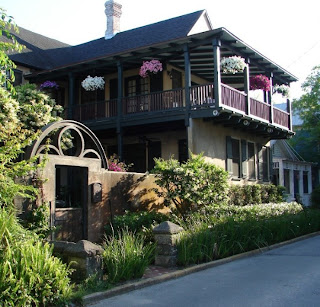
The garden is the combination of adjoining estates owned by two millionaire brothers from the turn of the century who donated the property to the museum. What we discovered is an area dedicated to quiet repose that overlooks the St. Johns River. As usual, click each photo for a better view.
 The entrance above has the look of going into a secret garden loaded with plants, fountains, and pergolas. I'm certain the brothers took their inspiration from gardens they saw in Europe as that was the trend at the time to make the voyage there and recreate items seen once you returned.
The entrance above has the look of going into a secret garden loaded with plants, fountains, and pergolas. I'm certain the brothers took their inspiration from gardens they saw in Europe as that was the trend at the time to make the voyage there and recreate items seen once you returned.A closer view of the little fountain that sits in the middle of the walk.
 This part of Florida is known for it's growth of oak trees and this one really impressed. It has stood for a millennium, and in the process of venerable growth the limbs have stretched in unbelievable shapes and directions. They not only reach to the sky but cover the ground. We both stood in awe because it is a fantastic sight.
This part of Florida is known for it's growth of oak trees and this one really impressed. It has stood for a millennium, and in the process of venerable growth the limbs have stretched in unbelievable shapes and directions. They not only reach to the sky but cover the ground. We both stood in awe because it is a fantastic sight. Under one of the pergolas I saw this vase that created the perfect mood of being in Italy rather than Florida.
Under one of the pergolas I saw this vase that created the perfect mood of being in Italy rather than Florida.
And the berries attached to the vine provided the perfect play of light to create a great shot.

This fountain made a leisurely afternoon of listening to the fall of water and the view of the river very enjoyable. We went later in the afternoon just before dark and we could understand how walking here could remove all the stress of the day for the financial titans.

This gargoyle was one of my favorites. It gives a sense of malevolence that seems to stare out at you.

I also find it strange that the side view which offers more detail does not seem as threatening.

And talk about a place for peaceful contemplation. This little pond has a raised seat that allows a great view. This shot was taken with the idea that this is what you would see if you were sitting on that concrete bench.
 Another of my favorite shots is this little fountain with a branch of the big oak suspended above it and a little boy among the plants. The sculpture is so life like I at first thought it was a real child playing in the flowers. It is such a charming view that you almost think you are a secret observer of a quiet moment.
Another of my favorite shots is this little fountain with a branch of the big oak suspended above it and a little boy among the plants. The sculpture is so life like I at first thought it was a real child playing in the flowers. It is such a charming view that you almost think you are a secret observer of a quiet moment.
And finally a real stolen moment: I saw this young woman quietly resting near a branch of the same great oak and it seemed like the perfect way to end the day.









































